Constructing digital signature algorithms based on new key schemes
he paper proposes a method of constructing digital signature algorithms based on the
new key schemes. The new key schemes are difficult problems that currently have no solution.
That algorithm construction method with a new key scheme is to improve the security of
digital signature algorithms. The new method is showed through the construction of two
specific digital signature algorithms and the generation of highly secure signature algorithms
that are constructed by this method is completely possible.
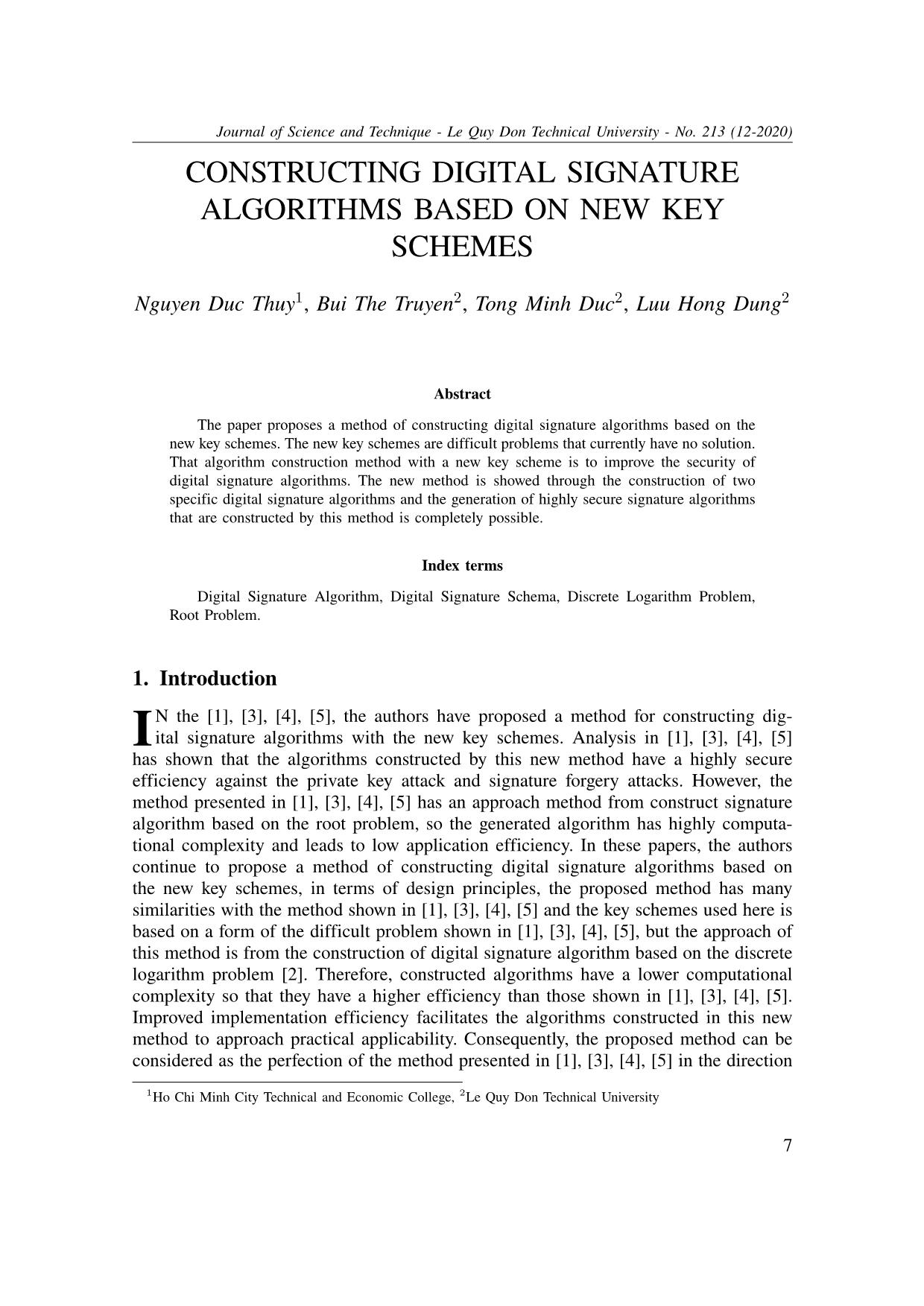
Trang 1
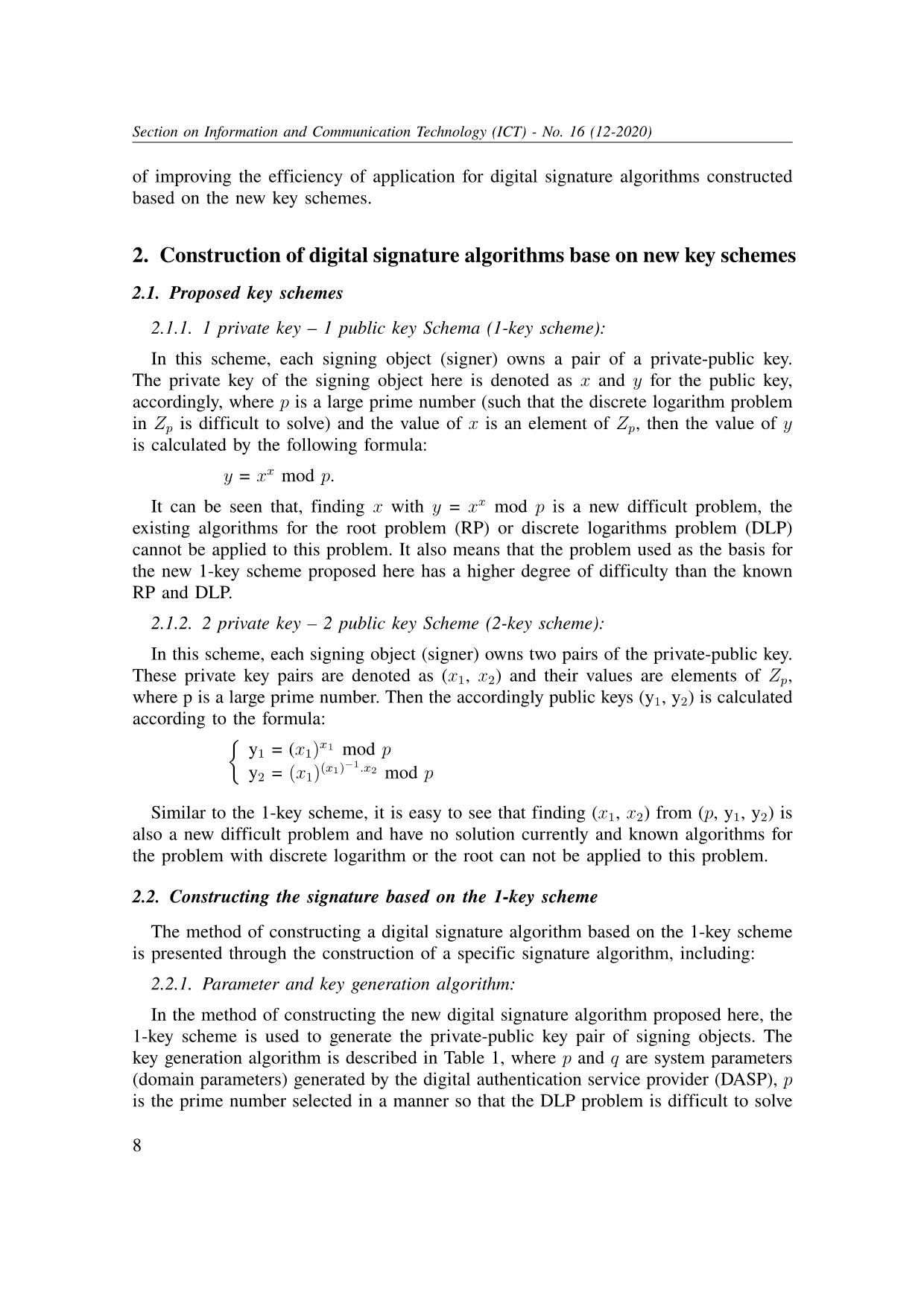
Trang 2
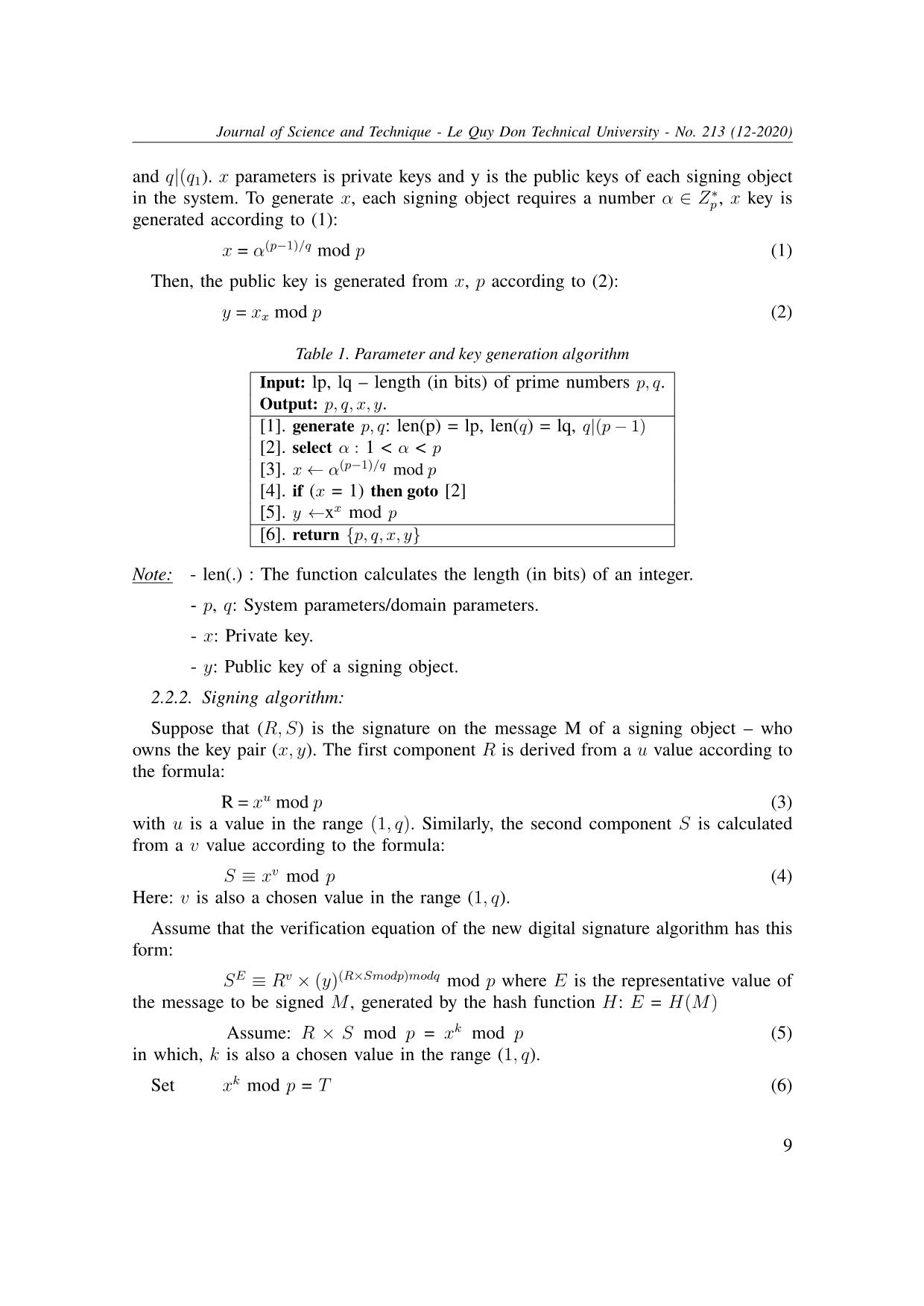
Trang 3
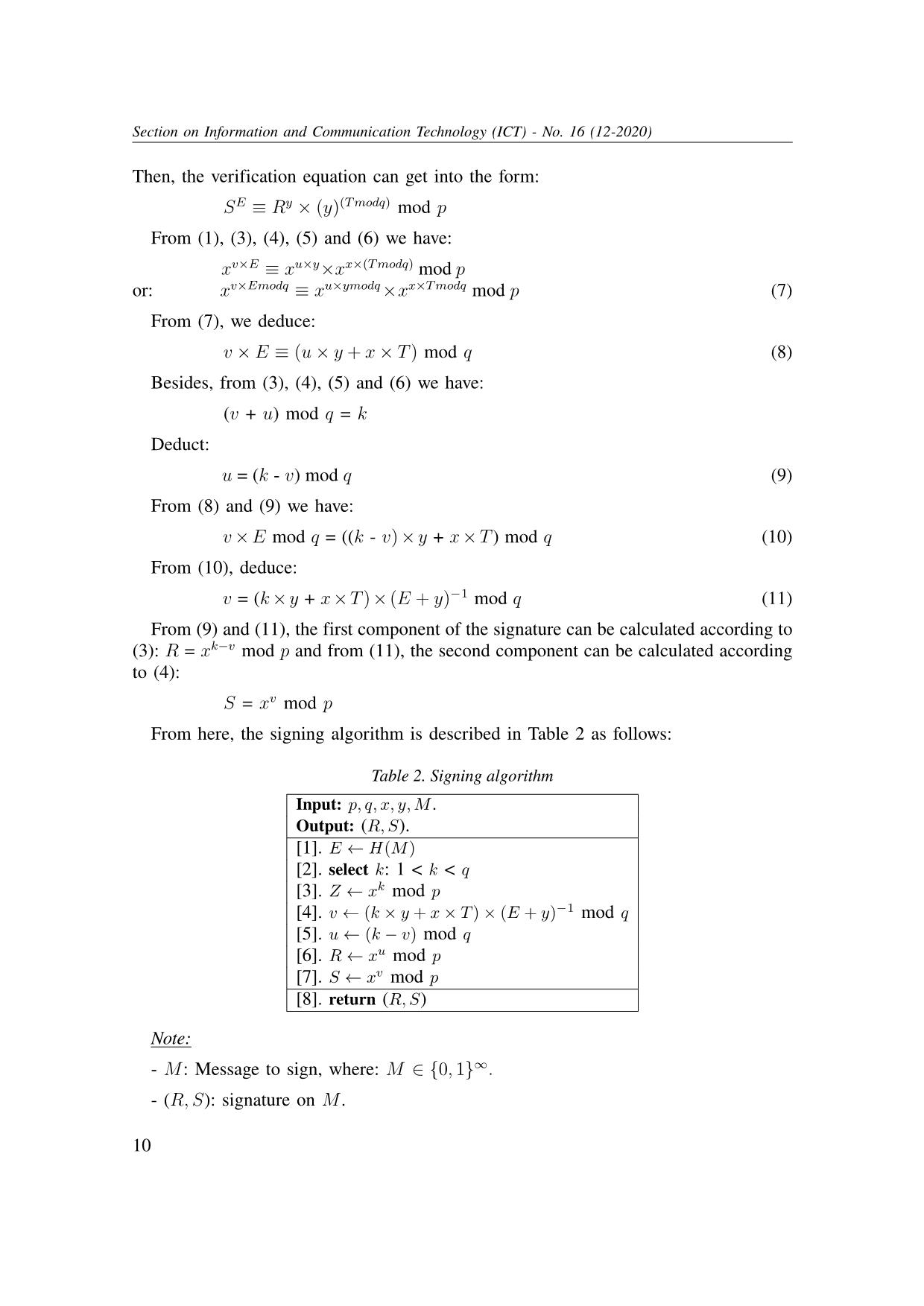
Trang 4
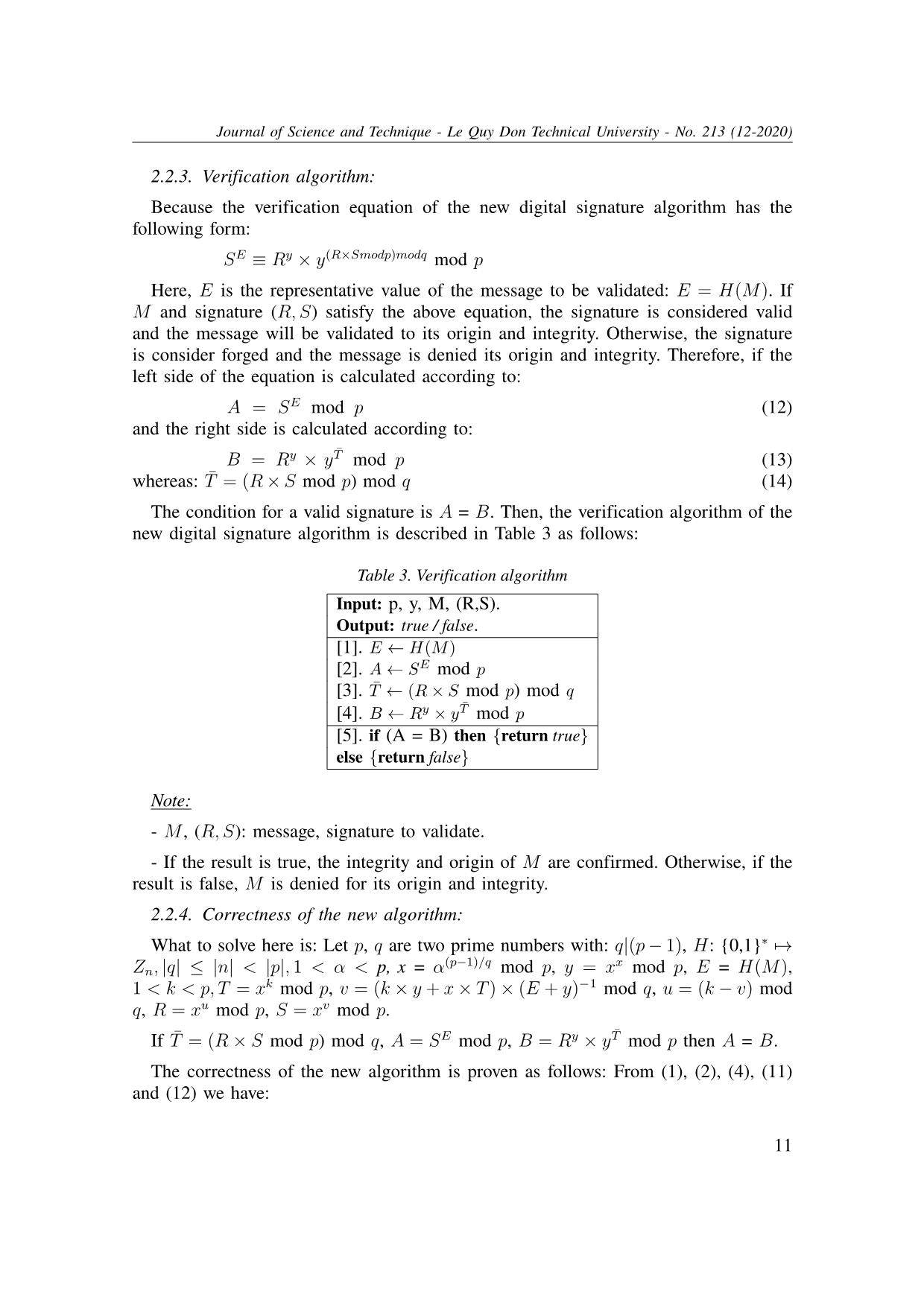
Trang 5
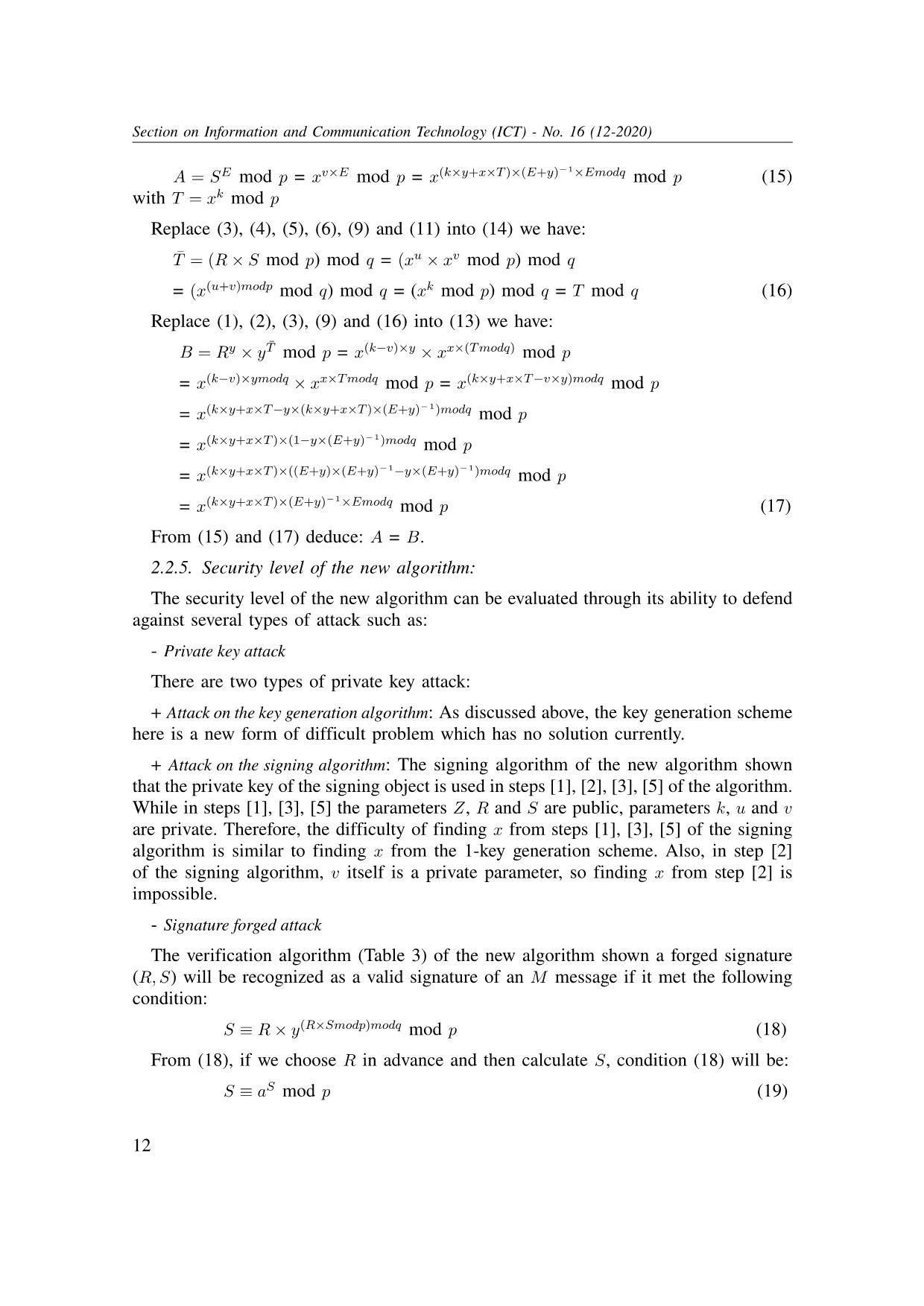
Trang 6
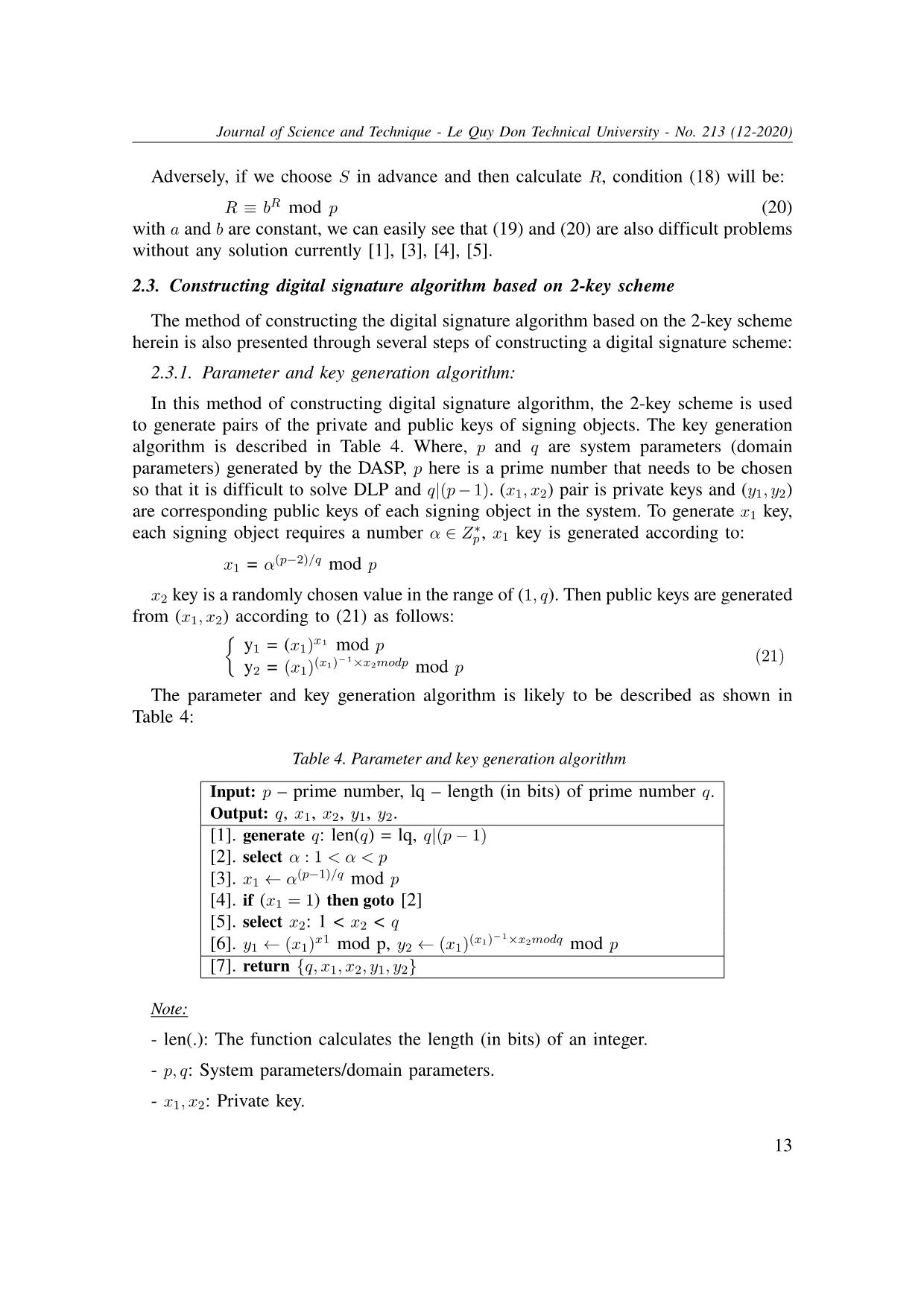
Trang 7
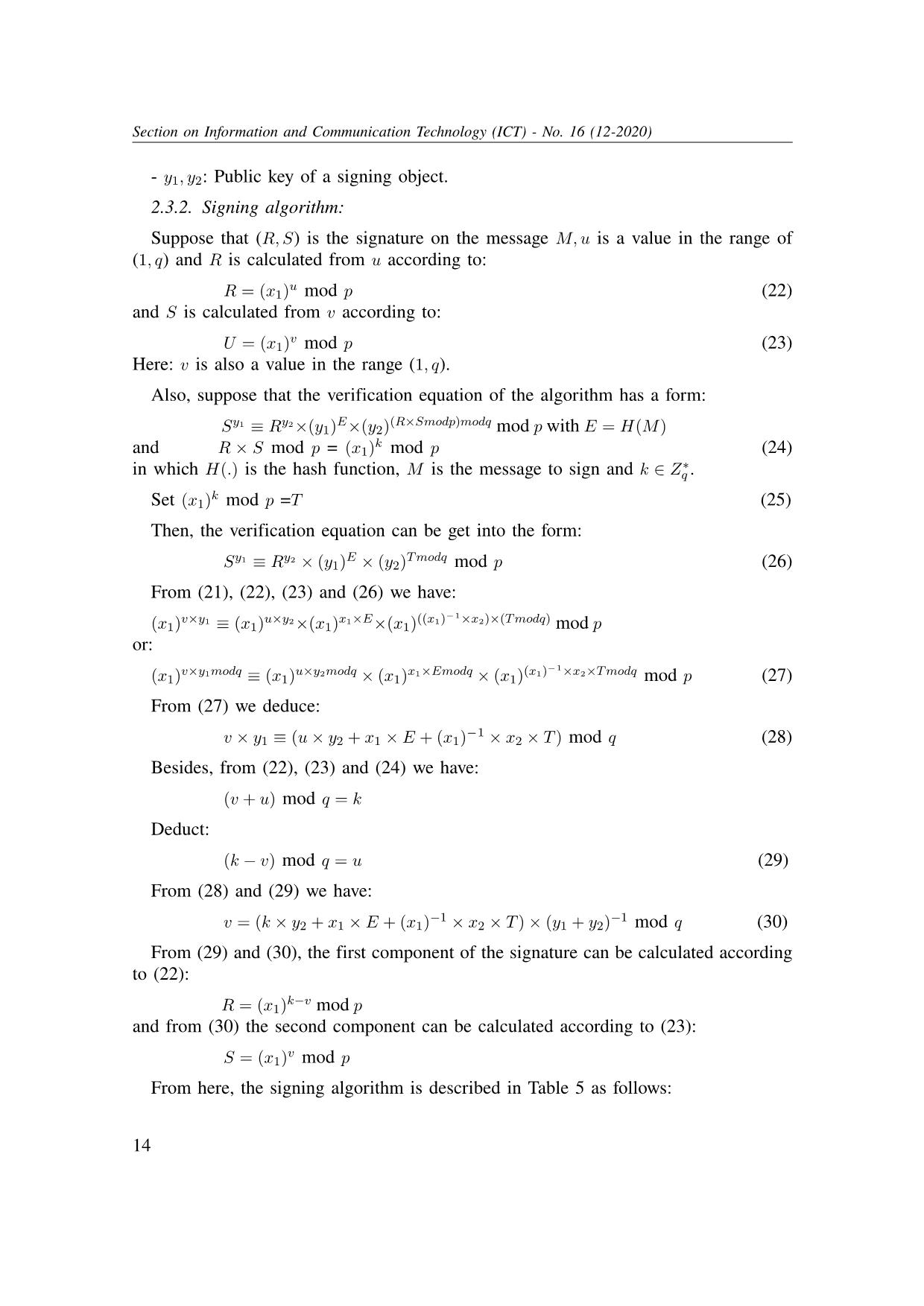
Trang 8
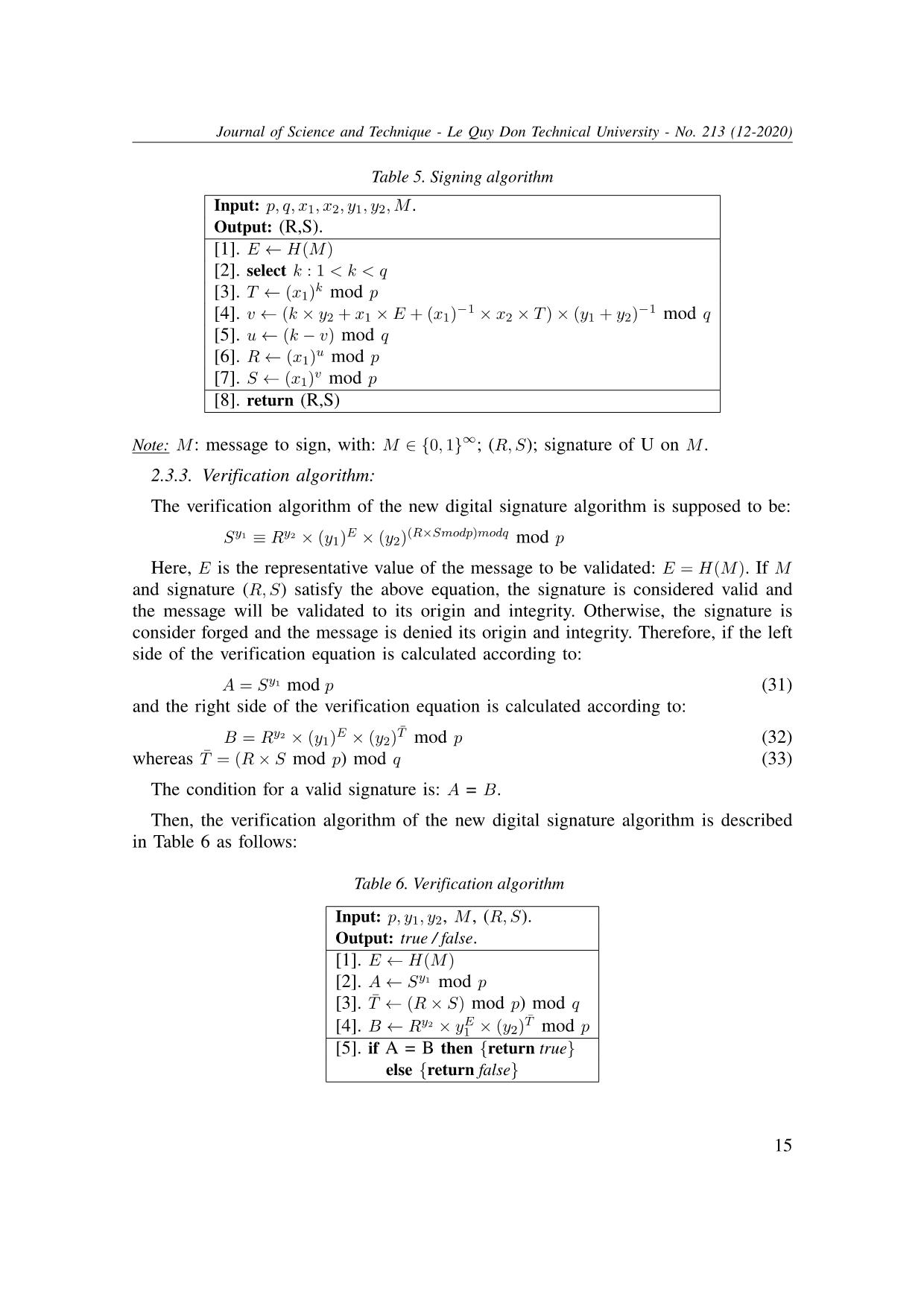
Trang 9
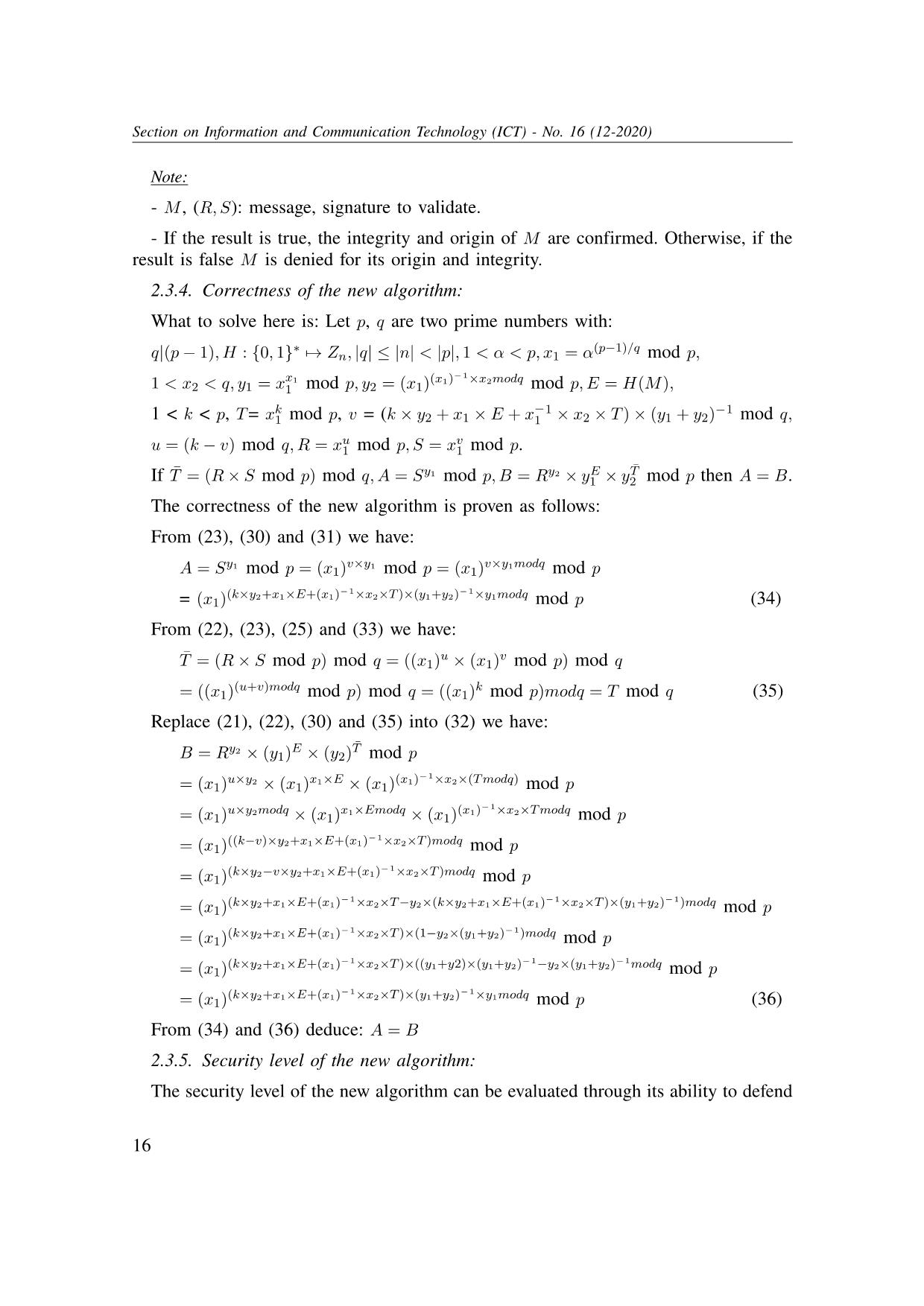
Trang 10
Tải về để xem bản đầy đủ
Bạn đang xem 10 trang mẫu của tài liệu "Constructing digital signature algorithms based on new key schemes", để tải tài liệu gốc về máy hãy click vào nút Download ở trên
Tóm tắt nội dung tài liệu: Constructing digital signature algorithms based on new key schemes
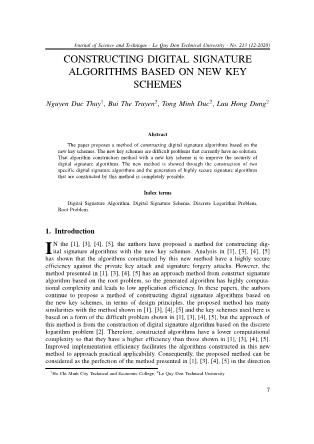
Journal of Science and Technique - Le Quy Don Technical University - No. 213 (12-2020)
CONSTRUCTING DIGITAL SIGNATURE
ALGORITHMS BASED ON NEW KEY
SCHEMES
Nguyen Duc Thuy1, Bui The Truyen2, Tong Minh Duc2, Luu Hong Dung2
Abstract
The paper proposes a method of constructing digital signature algorithms based on the
new key schemes. The new key schemes are difficult problems that currently have no solution.
That algorithm construction method with a new key scheme is to improve the security of
digital signature algorithms. The new method is showed through the construction of two
specific digital signature algorithms and the generation of highly secure signature algorithms
that are constructed by this method is completely possible.
Index terms
Digital Signature Algorithm, Digital Signature Schema, Discrete Logarithm Problem,
Root Problem.
1. Introduction
IN the [1], [3], [4], [5], the authors have proposed a method for constructing dig-ital signature algorithms with the new key schemes. Analysis in [1], [3], [4], [5]
has shown that the algorithms constructed by this new method have a highly secure
efficiency against the private key attack and signature forgery attacks. However, the
method presented in [1], [3], [4], [5] has an approach method from construct signature
algorithm based on the root problem, so the generated algorithm has highly computa-
tional complexity and leads to low application efficiency. In these papers, the authors
continue to propose a method of constructing digital signature algorithms based on
the new key schemes, in terms of design principles, the proposed method has many
similarities with the method shown in [1], [3], [4], [5] and the key schemes used here is
based on a form of the difficult problem shown in [1], [3], [4], [5], but the approach of
this method is from the construction of digital signature algorithm based on the discrete
logarithm problem [2]. Therefore, constructed algorithms have a lower computational
complexity so that they have a higher efficiency than those shown in [1], [3], [4], [5].
Improved implementation efficiency facilitates the algorithms constructed in this new
method to approach practical applicability. Consequently, the proposed method can be
considered as the perfection of the method presented in [1], [3], [4], [5] in the direction
1Ho Chi Minh City Technical and Economic College, 2Le Quy Don Technical University
7
Section on Information and Communication Technology (ICT) - No. 16 (12-2020)
of improving the efficiency of application for digital signature algorithms constructed
based on the new key schemes.
2. Construction of digital signature algorithms base on new key schemes
2.1. Proposed key schemes
2.1.1. 1 private key – 1 public key Schema (1-key scheme):
In this scheme, each signing object (signer) owns a pair of a private-public key.
The private key of the signing object here is denoted as x and y for the public key,
accordingly, where p is a large prime number (such that the discrete logarithm problem
in Zp is difficult to solve) and the value of x is an element of Zp, then the value of y
is calculated by the following formula:
y = xx mod p.
It can be seen that, finding x with y = xx mod p is a new difficult problem, the
existing algorithms for the root problem (RP) or discrete logarithms problem (DLP)
cannot be applied to this problem. It also means that the problem used as the basis for
the new 1-key scheme proposed here has a higher degree of difficulty than the known
RP and DLP.
2.1.2. 2 private key – 2 public key Scheme (2-key scheme):
In this scheme, each signing object (signer) owns two pairs of the private-public key.
These private key pairs are denoted as (x1, x2) and their values are elements of Zp,
where p is a large prime number. Then the accordingly public keys (y1, y2) is calculated
according to the formula:{
y1 = (x1)x1 mod p
y2 = (x1)(x1)
−1.x2 mod p
Similar to the 1-key scheme, it is easy to see that finding (x1, x2) from (p, y1, y2) is
also a new difficult problem and have no solution currently and known algorithms for
the problem with discrete logarithm or the root can not be applied to this problem.
2.2. Constructing the signature based on the 1-key scheme
The method of constructing a digital signature algorithm based on the 1-key scheme
is presented through the construction of a specific signature algorithm, including:
2.2.1. Parameter and key generation algorithm:
In the method of constructing the new digital signature algorithm proposed here, the
1-key scheme is used to generate the private-public key pair of signing objects. The
key generation algorithm is described in Table 1, where p and q are system parameters
(domain parameters) generated by the digital authentication service provider (DASP), p
is the prime number selected in a manner so that the DLP problem is difficult to solve
8
Journal of Science and Technique - Le Quy Don Technical University - No. 213 (12-2020)
and q|(q1). x parameters is private keys and y is the public keys of each signing object
in the system. To generate x, each signing object requires a number α ∈ Z∗p , x key is
generated according to (1):
x = α(p−1)/q mod p (1)
Then, the public key is generated from x, p according to (2):
y = xx mod p (2)
Table 1. Parameter and key generation algorithm
Input: lp, lq – length (in bits) of prime numbers p, q.
Output: p, q, x, y.
[1]. generate p, q: len(p) = lp, len(q) = lq, q|(p− 1)
[2]. select α : 1 < α < p
[3]. x← α(p−1)/q mod p
[4]. if (x = 1) then goto [2]
[5]. y ←xx mod p
[6]. return {p, q, x, y}
Note: - len(.) : The function calculates the length (in bits) of an integer.
- p, q: System parameters/domain parameters.
- x: Private key.
- y: Public key of a signing object.
2.2.2. Signing algorithm:
Suppose that (R, S) is the signature on the message M of a signing object – who
owns the key pair (x, y). The first component R is derived from ... ble 4. Where, p and q are system parameters (domain
parameters) generated by the DASP, p here is a prime number that needs to be chosen
so that it is difficult to solve DLP and q|(p− 1). (x1, x2) pair is private keys and (y1, y2)
are corresponding public keys of each signing object in the system. To generate x1 key,
each signing object requires a number α ∈ Z∗p , x1 key is generated according to:
x1 = α(p−2)/q mod p
x2 key is a randomly chosen value in the range of (1, q). Then public keys are generated
from (x1, x2) according to (21) as follows:{
y1 = (x1)x1 mod p
y2 = (x1)(x1)
−1×x2modp mod p (21)
The parameter and key generation algorithm is likely to be described as shown in
Table 4:
Table 4. Parameter and key generation algorithm
Input: p – prime number, lq – length (in bits) of prime number q.
Output: q, x1, x2, y1, y2.
[1]. generate q: len(q) = lq, q|(p− 1)
[2]. select α : 1 < α < p
[3]. x1 ← α(p−1)/q mod p
[4]. if (x1 = 1) then goto [2]
[5]. select x2: 1 < x2 < q
[6]. y1 ← (x1)x1 mod p, y2 ← (x1)(x1)−1×x2modq mod p
[7]. return {q, x1, x2, y1, y2}
Note:
- len(.): The function calculates the length (in bits) of an integer.
- p, q: System parameters/domain parameters.
- x1, x2: Private key.
13
Section on Information and Communication Technology (ICT) - No. 16 (12-2020)
- y1, y2: Public key of a signing object.
2.3.2. Signing algorithm:
Suppose that (R,S) is the signature on the message M,u is a value in the range of
(1, q) and R is calculated from u according to:
R = (x1)
u mod p (22)
and S is calculated from v according to:
U = (x1)
v mod p (23)
Here: v is also a value in the range (1, q).
Also, suppose that the verification equation of the algorithm has a form:
Sy1 ≡ Ry2×(y1)E×(y2)(R×Smodp)modq mod p with E = H(M) and
and R × S mod p = (x1)k mod p (24)
in which H(.) is the hash function, M is the message to sign and k ∈ Z∗q .
Set (x1)k mod p =T (25)
Then, the verification equation can be get into the form:
Sy1 ≡ Ry2 × (y1)E × (y2)Tmodq mod p (26)
From (21), (22), (23) and (26) we have:
(x1)
v×y1 ≡ (x1)u×y2×(x1)x1×E×(x1)((x1)−1×x2)×(Tmodq) mod p or:
or:
(x1)
v×y1modq ≡ (x1)u×y2modq × (x1)x1×Emodq × (x1)(x1)−1×x2×Tmodq mod p (27)
From (27) we deduce:
v × y1 ≡ (u× y2 + x1 × E + (x1)−1 × x2 × T ) mod q (28)
Besides, from (22), (23) and (24) we have:
(v + u) mod q = k
Deduct:
(k − v) mod q = u (29)
From (28) and (29) we have:
v = (k × y2 + x1 × E + (x1)−1 × x2 × T )× (y1 + y2)−1 mod q (30)
From (29) and (30), the first component of the signature can be calculated according
to (22):
R = (x1)
k−v mod p and
and from (30) the second component can be calculated according to (23):
S = (x1)
v mod p
From here, the signing algorithm is described in Table 5 as follows:
14
Journal of Science and Technique - Le Quy Don Technical University - No. 213 (12-2020)
Table 5. Signing algorithm
Input: p, q, x1, x2, y1, y2,M .
Output: (R,S).
[1]. E ← H(M)
[2]. select k : 1 < k < q
[3]. T ← (x1)k mod p
[4]. v ← (k × y2 + x1 × E + (x1)−1 × x2 × T )× (y1 + y2)−1 mod q
[5]. u← (k − v) mod q
[6]. R← (x1)u mod p
[7]. S ← (x1)v mod p
[8]. return (R,S)
Note: M : message to sign, with: M ∈ {0, 1}∞; (R,S); signature of U on M .
2.3.3. Verification algorithm:
The verification algorithm of the new digital signature algorithm is supposed to be:
Sy1 ≡ Ry2 × (y1)E × (y2)(R×Smodp)modq mod p
Here, E is the representative value of the message to be validated: E = H(M). If M
and signature (R,S) satisfy the above equation, the signature is considered valid and
the message will be validated to its origin and integrity. Otherwise, the signature is
consider forged and the message is denied its origin and integrity. Therefore, if the left
side of the verification equation is calculated according to:
A = Sy1 mod p (31)
and the right side of the verification equation is calculated according to:
B = Ry2 × (y1)E × (y2)T¯ mod p (32)
whereas T¯ = (R× S mod p) mod q (33)
The condition for a valid signature is: A = B.
Then, the verification algorithm of the new digital signature algorithm is described
in Table 6 as follows:
Table 6. Verification algorithm
Input: p, y1, y2, M , (R,S).
Output: true / false.
[1]. E ← H(M)
[2]. A← Sy1 mod p
[3]. T¯ ← (R× S) mod p) mod q
[4]. B ← Ry2 × yE1 × (y2)T¯ mod p
[5]. if A = B then {return true}
else {return false}
15
Section on Information and Communication Technology (ICT) - No. 16 (12-2020)
Note:
- M , (R,S): message, signature to validate.
- If the result is true, the integrity and origin of M are confirmed. Otherwise, if the
result is false M is denied for its origin and integrity.
2.3.4. Correctness of the new algorithm:
What to solve here is: Let p, q are two prime numbers with:
q|(p− 1), H : {0, 1}∗ 7→ Zn, |q| ≤ |n| < |p|, 1 < α < p, x1 = α(p−1)/q mod p,
1 < x2 < q, y1 = x
x1
1 mod p, y2 = (x1)(x1)
−1×x2modq mod p,E = H(M),
1 < k < p, T= xk1 mod p, v = (k × y2 + x1 ×E + x−1 1 × x2 × T )× (y1 + y2)−1 mod q,
u = (k − v) mod q,R = xu1 mod p, S = xv1 mod p.
If T¯ = (R× S mod p) mod q, A = Sy1 mod p,B = Ry2 × yE1 × yT¯2 mod p then A = B.
The correctness of the new algorithm is proven as follows:
From (23), (30) and (31) we have:
A = Sy1 mod p = (x1)v×y1 mod p = (x1)v×y1modq mod p
= (x1)(k×y2+x1×E+(x1)
−1×x2×T )×(y1+y2)−1×y1modq mod p (34)
From (22), (23), (25) and (33) we have:
T¯ = (R× S mod p) mod q = ((x1)u × (x1)v mod p) mod q
= ((x1)
(u+v)modq mod p) mod q = ((x1)k mod p)modq = T mod q (35)
Replace (21), (22), (30) and (35) into (32) we have:
B = Ry2 × (y1)E × (y2)T¯ mod p
= (x1)
u×y2 × (x1)x1×E × (x1)(x1)−1×x2×(Tmodq) mod p
= (x1)
u×y2modq × (x1)x1×Emodq × (x1)(x1)−1×x2×Tmodq mod p
= (x1)
((k−v)×y2+x1×E+(x1)−1×x2×T )modq mod p
= (x1)
(k×y2−v×y2+x1×E+(x1)−1×x2×T )modq mod p
= (x1)
(k×y2+x1×E+(x1)−1×x2×T−y2×(k×y2+x1×E+(x1)−1×x2×T )×(y1+y2)−1)modq mod p
= (x1)
(k×y2+x1×E+(x1)−1×x2×T )×(1−y2×(y1+y2)−1)modq mod p
= (x1)
(k×y2+x1×E+(x1)−1×x2×T )×((y1+y2)×(y1+y2)−1−y2×(y1+y2)−1modq mod p
= (x1)
(k×y2+x1×E+(x1)−1×x2×T )×(y1+y2)−1×y1modq mod p (36)
From (34) and (36) deduce: A = B
2.3.5. Security level of the new algorithm:
The security level of the new algorithm can be evaluated through its ability to defend
16
Journal of Science and Technique - Le Quy Don Technical University - No. 213 (12-2020)
against several types of attack such as:
- Private key attack:
There are two types of private key attacks: Attack on the key generation algorithm
and attack on the signing algorithm, perform a similar analysis to the 1-key scheme, it
shows that the private key attack against schemes constructed by this method is always
challenged with a difficult problem without solution currently.
- Attack on the forged signature:
The verification algorithm (Table 6) of the new algorithm algorithm shows a forged
signature (R,S) will be recognized as a valid signature of an M message if it met the
following condition:
(S)y1 ≡ (R)y2 × (y1)E × (y2)(R×Smodp)modq mod p (37)
From (37), if we choose R in advance and then calculate S, condition (37) will be:
(S)y1 ≡ as mod p (38)
Adversely, if we choose S in advance and then calculate R, condition (37) will be:
(R)y2 ≡ bR mod p (39)
with a and b are constant, we can easily see that (38) and (39) are also difficult problems
without any solution currently [1], [3], [4], [5].
2.4. Some evaluation of the application efficiency of signature schemes constructed
based on the new method
The effectiveness of the digital signature algorithm can be evaluated through the
cost of executing the signing algorithm, verification algorithm, and signature size that
the schema generates. In this section, the effectiveness of the new algorithm will be
evaluated and compared with the results in
2.4.1. Signature size:
It can be seen that with the same parameter set (p, q), the size of signatures generated
by the 2 schemes herein and those in [1], [3], [4], [5] are equivalent.
2.4.2. Executing cost:
Executing cost or computation cost of the signing and verification algorithms can be
evaluated by the number of computations to be performed or total computation time of
the signing and verification algorithms, the convention of the use of symbols as bellows:
Texp: The execution time of the modular exponentiation.
Th: The execution time of the hash function.
Tmul: The execution time of the modulo multiplication.
Tinv: The execution time of the modular inverse.
17
Section on Information and Communication Technology (ICT) - No. 16 (12-2020)
Attention:
The key and parameter generation algorithm only needs to be executed once for all
signing objects. Therefore, the computation cost for the key and parameter generation
algorithm can be ignored when calculating the cost of performing the digital signature
algorithm.
The executing cost for the signing algorithm (1) and verification algorithm (2) of
algorithms in [1], [3], [4], [5] and the 2 new algorithms are shown in Table 7 as
follows:
Table 7. Executing cost for digital signature algorithms
Texp Tmul Tinv Th
(1) (2) (1) (2) (1) (2) (1) (2)
Algorithm [1] 8 3 7 2 3 0 1 1
Algorithm [2] 7 3 6 2 4 0 1 1
Algorithm [3] 6 3 5 2 5 0 1 1
Algorithm [4] 6 3 4 2 4 0 1 1
Algorithm with 1-key scheme 3 3 3 2 1 0 1 1
Algorithm with 2-key scheme 3 4 5 3 2 0 1 1
Note:
- The Algorithms [1], [3], [4] are signature algorithms proposed in [1], [3] and [4].
- The Algorithm [2] is a signature algorithm proposed in "C. Constructing digital
signature schema based on the difficulty of solving expanded root problem" in [2].
- The Algorithm with 1-key and 2-key scheme is 2 signature algorithms constructed
based on the newly proposed method here.
Remark:
Results in Table 3.1 shows that amount/duration to perform the calculations of the
two algorithms constructed according to the new method is lower than those on the
algorithms in [1], [3], [4], [5], thereby showing that the application efficiency of these
algorithms is higher than those on the earlier proposed algorithms.
3. Conclusion
In this paper, the authors proposed a method to construct digital signature algorithms
based on new key schemes to improve the security of the algorithms. The security of
the algorithms constructed in this method is always guaranteed by difficult problems
without a solution currently. Besides, the issue of improving efficiency for signature
algorithms constructed by the proposed method in [1], [3], [4], [5] is also solved to
meet the requirements of application algorithms in practice.
18
Journal of Science and Technique - Le Quy Don Technical University - No. 213 (12-2020)
References
[1] Luu Hong Dung, Tong Minh Duc, and Luu Xuan Van. A new method for constructing digital signature schemes
base on difficulty of the integer factorization and discrete logarithm root problems the zn. In Fundamental and
Applied IT Research Conference, pages 1–9, 2018.
[2] Dung Luu Hong et al. A new construction method of digital signature algorithms. International Journal of
Computer Science and Network Security (IJCSNS), 16(12):53, 2016.
[3] Dung Luu Hong et al. A new digital signature scheme based on the hardness of some expanded root problems.
Procedia Computer Science, 171:541–550, 2020.
[4] Luu Xuan Van and Luu Hong Dung. Constructing a digital signature algorithm based on the difficulty of some
expanded root problems. In 2019 6th NAFOSTED Conference on Information and Computer Science (NICS),
pages 190–195. IEEE, 2019.
[5] Luu Xuan Van, Luu Hong Dung, and Doan Van Hoa. Developing root problem aims to create a secure digital
signature scheme in data transfer. In 2020 International Conference on Green and Human Information Technology
(ICGHIT), pages 25–30. IEEE, 2020.
Manuscript received: 15-07-2020; Accepted: 30-10-2020
Nguyen Duc Thuy Graduated in Information Technology University of Foreign Languages;
Informatics University of Ho Chi Minh City in 2005, Master degree from Academy of Eco-
nomics and Business in 2013; Currently working in the Faculty of Information Technology -
Ho Chi Minh City Technical and Economic College; Research field: information security.
Bui The Truyen graduated from Le Quy Don Technical University in 2000. He received a
doctor’s degree in analysis and information processing at Moscow Aviation Institute, Russia
in 2008. Currently a lecturer at the Le Quy Don Technical University. His research interests
are virtual reality simulation and information security. E-mail: truyenbuithe@lqdtu.edu.vn
Tong Minh Duc graduated from Le Quy Don Technical University in 2000. Received a
doctorate from University of Electrical Engineering - Russia in 2007. Currently a lecturer at the
Faculty of Information Technology - Le Quy Don Technical University. Research field: Image
processing, object identification, information security safety. E-mail: ducmta@gmail.com
19
Section on Information and Communication Technology (ICT) - No. 16 (12-2020)
Luu Hong Dung graduated in Electronics and Communications from Le Quy Don Technical
University in 1989, PhD at Le Quy Don Technical University in 2013; Currently working in
the IT department - Le Quy Don Technical University; Research direction: Cryptography and
information security. E-mail: luuhongdung@gmail.com
XÂY DỰNG THUẬT TOÁN KÝ SỐ DỰA TRÊN
CÁC SƠ ĐỒ KHÓA MỚI
Tóm tắt
Bài báo đề xuất một phương pháp xây dựng các thuật toán chữ ký số dựa trên các sơ
đồ khóa mới. Các sơ đồ khóa mới được sử dụng ở đây thực chất là một dạng bài toán khó
mà hiện tại còn chưa có cách giải. Phương pháp xây dựng thuật toán với các sơ đồ tạo khóa
mới như thế được đề xuất nhằm mục đích nâng cao mức độ an toàn cho các thuật toán chữ
ký số. Phương pháp mới đề xuất ở đây được trình bày thông qua việc xây dựng 2 thuật toán
chữ ký số cụ thể, song hoàn toàn có thể tạo ra một lớp thuật toán chữ ký có độ an toàn cao
cũng bằng chính phương pháp này.
20
File đính kèm:
 constructing_digital_signature_algorithms_based_on_new_key_s.pdf
constructing_digital_signature_algorithms_based_on_new_key_s.pdf

